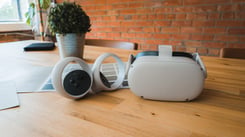People are naturally resistant to change not only because of the discomfort but also because of legitimate fears about losing efficiency. When deadlines are pressing, people don’t want to take additional time to try new software or build render time into their workflow.
With a little education, you can overcome this hesitation and lead VR adoption for your business. Take a look at some of the key insights from our Client Success Manager, Dana Warren (DW), as she discusses working with VR. We’ll help you learn how to adopt the technology to wow your clients and feel confident in every client interaction.
What do you think are the biggest hesitations people have when they start working with virtual reality?
DW - The biggest hurdle I find users have trouble with is figuring out how they want to adopt VR into their workflow. Designing in a CAD program is already time-consuming, so they feel like adding a new step to the workflow is daunting; but it honestly comes down to the rendering stage. You can render VR-compatible scenes with our CAD plugins, which means all you’ll need to do is upload your files to Yulio and click ‘View in VR’ to send them to the Yulio Viewer app on your phone.
New technology can seem intimidating, but Yulio was designed to be used by anyone. Things like our CAD plugins and authoring within Yulio may seem complicated, but we can assure you that the workflow process for you is not changing much, and anything you’re unfamiliar with is a small learning curve in the scheme of things. We’re here to make sure you have success with your clients so anything you run into we can help you overcome.
What are the most common questions you get from users who are just starting out?
DW -The main question I get is surrounding where the VR content comes from. Once users sign-up, they find that they’re inside our interface, but they aren’t sure how to get started working with virtual reality as they may not know how to create content.
Here is where our CAD plugins come in. If you install the plugin that matches the CAD program in your workflow, you can make any 3D CAD design into a VR design. Click on the Yulio plugin button in your CAD program, and once the project is done rendering, you can upload the cubemap file to Yulio, and there you go - a virtual reality experience you can share with your clients. You can start working with VR in this way in minutes.
We also get a lot of inquiries from new users asking about what kind of headset they should use or buy. When people think about VR, they picture tethered VR, which isn't as easy to use in business - you have to have someone on site for every meeting, you have to watch for safety and clients have a greater chance of experiencing nausea.
Yulio focuses solely on a mobile virtual reality experience because of the simplicity, mobility, and how intuitive it is for all kinds of users. We typically recommend the Samsung Gear VR (about $100 and widely available on Amazon) for a higher-end mobile experience, or there’s also the Homido mini or Google Cardboard which still provide great viewing experiences, but with a smaller price tag of $10-$15.
Another common question we get is around how to share a virtual reality project with clients or coworkers. This is where Yulio shines - it’s all about making you look good in front of your clients, and is a simple presentation tool for working with VR. Yulio has two ways of sharing; link, and embed.
If you want to privately share your VR project, then sharing a link would be the way to go. Every VR project has a unique URL associated with it, and you have the freedom to share this link with the audience of your choosing. If you and your clients know how to work with a URL, it’s just the same.
You can also embed any VR experience on your website - you can find the embed code for your website under the sharing link, but just like a video or other resources, you just use the code to add to the site.
What’s the best way for new users to start working with VR?
DW - If I could recommend one thing it would be to just dive in. Give yourself an hour or so and just explore the features and functions, maybe read through some our resources - once you spend time learning the technology, I can promise you that you’re going to become an expert. And that one-hour investment is going to do amazing things for your business - VR adopters find they:
- Are perceived as leaders in their industry for having adopted new technology
- Have better, more engaging conversations with clients who better understand their design presentations
- Get to decision making faster, with fewer meetings since VR brings clarity
- Have fewer late-stage changes as their clients are in sync with the design from the beginning
Some resources we have on-hand include, ‘‘how-to” video walkthroughs on our Youtube channel, we have our knowledge base and FAQ’s to answer some of your questions, a live chat on our website which I answer within hours, so if you can’t find an answer you can definitely reach out to me there.
Finally, we just started hosting weekly training webinars to introduce new users to Yulio, and help you with getting started with virtual reality. Grab a spot any week, here.
Do you have any tips or tricks for users who are just starting to use VR?
DW - Some tips that I find helpful and useful when working with VR are:
- In your CAD program, set the camera height to 5’6” - This is the average height of people in North America. It’ll give you a good perspective height when you’re viewing the VR project. And think about the camera position your client will see at the start of the experience - you don’t want them facing a blank wall, so you have to consider that starting spot
- Depending on the headset that you’re using, VR can be isolating; which is why we remove head straps on our headsets. This makes it easier to pop in and out of virtual reality to keep the discussion with clients flowing.
- Next, really think about what you’re designing for. When you’re designing for virtual reality, you have to keep in mind that the user can look all around them as opposed to in one single direction. So remember to design for above, behind, and below your client as well as key areas that you want to showcase.
- Finally, think about the story you’re trying to tell, and how you can get that across with features like audio and navigational hotspots. You want to paint more than just a pretty picture, you want to captivate your client and truly allow them to see your vision come to life in front of their eyes.
A big thank you to Dana for sharing her knowledge and insights, and for providing so much ongoing support. She will be continuing to host our weekly training webinars for new users every Thursday at 1 pm EST. At these webinars, Dana will equip you with everything you need to know to start creating awesome VR presentations for your clients using Yulio.
She’ll take you through things like:
- Business use-cases and real examples of VR projects from our clients,
- How to create a VR project from rendering to authoring
- Customizing and enhancing your VR project to be the best it can be
- Go through CAD plugins within the actual programs themselves
On top of all of that, the webinar is completely live so you can feel free to stop and ask questions at every step of the process and she’ll do her best to address all of your comments, questions, and concerns.
If you’re interested in joining one of our weekly webinar training sessions, you can sign up here. Or if you want to give Yulio a try you can sign up here and get access to a Yulio account and test our all our features for free.



.jpg?width=245&height=150&name=active-adult-beautiful-1799244%20(1).jpg)


